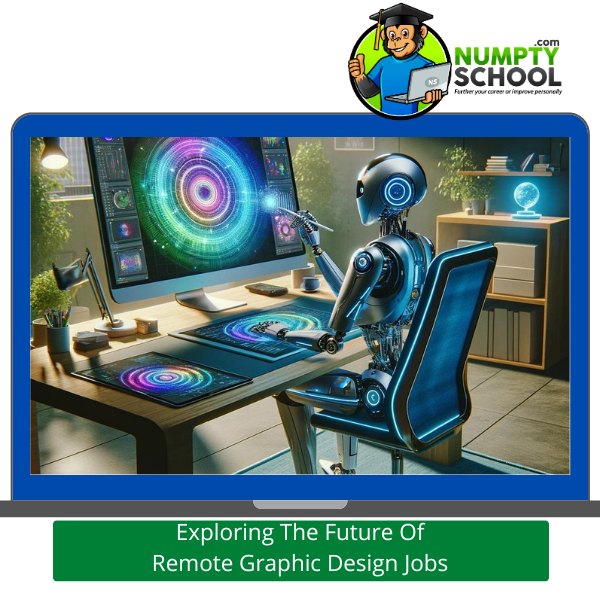Exploring The Future Of Remote Graphic Design Jobs

In recent years, the landscape of employment has undergone a significant transformation, with remote work emerging as a prominent trend across various industries. Among these changes, the future of remote graphic design jobs holds particular intrigue and promise. This article delves into the evolving nature of remote graphic design work, exploring current trends, technological advancements, and the potential challenges and opportunities that lie ahead.
Current Landscape of Remote Graphic Design Jobs
Remote graphic design jobs offer numerous benefits for both employers and employees. For businesses, hiring remote graphic designers allows access to a global talent pool, enabling them to find the best fit for their projects without being limited by geographical boundaries. On the other hand, remote work provides graphic designers with flexibility in their schedules, the ability to work from anywhere, and a better work-life balance.
However, remote graphic designers also face challenges such as communication barriers, potential feelings of isolation, and the need for self-discipline to stay productive outside of a traditional office environment.
Technology’s Role in Remote Graphic Design
Advancements in technology play a crucial role in shaping the landscape of remote graphic design. Collaboration tools such as Slack, Trello, and Asana facilitate communication and project management among remote teams. Cloud-based software like Adobe Creative Cloud allows designers to access their work from anywhere with an internet connection, eliminating the need for physical storage devices.
Moreover, emerging technologies such as virtual reality (VR) and augmented reality (AR) present new opportunities for remote graphic designers to create immersive and interactive experiences for their clients and audiences.
Trends Shaping the Future of Remote Graphic Design
Several trends are driving the future of remote graphic design jobs. The increasing demand for digital content across various platforms, including social media, websites, and mobile applications, creates abundant opportunities for graphic designers to showcase their skills and expertise.
Additionally, there is a growing emphasis on user experience (UX) design, with businesses recognizing the importance of creating seamless and intuitive digital experiences for their customers. This trend underscores the significance of remote graphic designers in shaping the digital landscape of the future.
Impact of AI and Automation on Remote Graphic Design
AI and automation are poised to revolutionize the field of graphic design, streamlining repetitive tasks and enhancing the creative process. While some may fear that AI will replace human designers, the reality is that it can serve as a valuable tool for assisting designers in generating ideas, optimizing workflows, and improving efficiency.
By leveraging AI-powered design tools, remote graphic designers can focus more on conceptualization and strategy, allowing them to deliver higher-quality work in less time.
The Importance of Soft Skills in Remote Graphic Design
In addition to technical skills, soft skills are essential for success in remote graphic design jobs. Effective communication skills are vital for collaborating with clients and team members, especially when working remotely. Time management and self-discipline are also crucial, as remote designers must manage their time effectively and stay motivated without direct supervision.
Education and Training for Remote Graphic Designers
The rapid evolution of technology requires remote graphic designers to continually update their skills and stay abreast of industry trends. Fortunately, there is a wealth of online courses, tutorials, and certifications available to help designers sharpen their skills and expand their knowledge.
Continuous learning and upskilling are essential for remote graphic designers to remain competitive in the ever-changing landscape of digital design.
Creating a Personal Brand as a Remote Graphic Designer
Building a strong personal brand is essential for remote graphic designers to stand out in a competitive market. A compelling online portfolio showcasing past projects and client testimonials can help designers attract potential clients and establish credibility in their field.
Furthermore, networking through social media platforms, online communities, and industry events can help remote graphic designers connect with peers, mentors, and potential collaborators.
Balancing Work-Life in Remote Graphic Design Jobs
While remote work offers flexibility and freedom, it also requires remote graphic designers to establish boundaries between work and personal life. Setting clear work hours, creating a designated workspace, and taking regular breaks are essential for maintaining a healthy work-life balance.
Prioritizing self-care and mental well-being is equally important, as remote graphic designers may experience feelings of isolation or burnout if they neglect their physical and emotional health.
Overcoming Isolation and Maintaining Motivation
Working remotely can sometimes lead to feelings of isolation, especially for individuals accustomed to the social aspect of office environments. To combat loneliness, remote graphic designers can take proactive steps to stay connected with other remote workers through online communities, networking events, and virtual coworking spaces.
Seeking mentorship and support from more experienced designers can also provide valuable guidance and motivation for remote graphic designers navigating their career paths.
The Future of Remote Graphic Design: Opportunities and Challenges
Looking ahead, the future of remote graphic design holds immense potential for growth and innovation. The flexibility and freedom offered by remote work will continue to attract talented designers from around the world, fostering a diverse and dynamic creative community.
Furthermore, advancements in technology and the increasing demand for digital content present abundant opportunities for remote graphic designers to expand their skills and explore new avenues of creativity.
However, remote graphic designers must also address challenges such as cybersecurity concerns and the need for effective communication and collaboration in virtual environments. By embracing these opportunities and overcoming challenges, remote graphic designers can shape the future of digital design and contribute to the continued evolution of the industry.
Conclusion
In conclusion, the future of remote graphic design jobs is bright and full of exciting possibilities. As technology continues to advance and the demand for digital content grows, remote graphic designers will play an increasingly vital role in shaping the visual landscape of the future. By embracing remote work, leveraging technology, and honing their skills, graphic designers can thrive in a rapidly evolving industry and contribute to the creation of innovative and impactful designs.
FAQs (Frequently Asked Questions)
Q) What skills are essential for remote graphic designers?
A) Remote graphic designers should possess a combination of technical skills such as proficiency in design software and programming languages, as well as soft skills like communication, time management, and creativity.
Q) How can remote graphic designers stay motivated while working independently?
A) Setting clear goals, creating a structured work environment, and seeking inspiration from peers and mentors can help remote graphic designers stay motivated and productive.
Q) What are some effective strategies for networking as a remote graphic designer?
A) Participating in online communities, attending virtual events and workshops, and utilizing social media platforms to connect with industry professionals can help remote graphic designers expand their networks and build meaningful relationships.
Q) How can remote graphic designers maintain a healthy work-life balance?
A) Establishing boundaries between work and personal life, prioritizing self-care and mental well-being, and taking regular breaks are essential for maintaining a healthy work-life balance as a remote graphic designer.
Q) What are some emerging trends in the field of remote graphic design?
A) Emerging trends in remote graphic design include the increased demand for digital content, the emphasis on user experience (UX) design, and the integration of AI and automation into the creative process.



